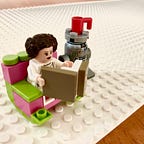3 Strategies For A Successful Vacation With An Apprehensive Child
Plan ahead to relieve travel stress in your child.
This story was originally published on November 29, 2016 on The DIS.
Search for “Disney World reveal videos,” and you will find millions of results. The authentic ones are sweet, if not slightly gag-inducing, private moments of families celebrating an upcoming adventure. Some families make the big announcement on the way to the airport or once they’re packed for the road trip, and there is no turning back. That is the definition of disaster for a family with a child who struggles with anxiety and rigidity.
Parents of children with developmental challenges know that daily activities are stressful enough, without throwing travel into the mix. Any disruption to the routine can unsettle a child and make recovery difficult. Although it is tempting to not travel at all, there are ways to alleviate the pressure of vacation.
Expose Kids To Similar Situations
Before a vacation, find local destinations that contain elements similar to those you plan to experience. Visiting a popular park or festival can provide conditions such as crowds, waiting in long lines, live music, or fireworks. A movie theater can give the experience of a dark place with unexpected loud noises. It’s useful to assess these stimulants before visiting a theme park or museum with IMAX and interactive experiences.
For a beach or water park vacation, swimming lessons are a great way to boost a child’s confidence, and group lessons give them the experience of other kids being around in the water. Exposing a sensory-sensitive child to sand is essential if the beach is part of your vacation plans. The unique feeling of the sand and the way it sticks to the body can lead kids straight to a meltdown if they are not expecting it. Couple this exposure with a lesson on all the great ways to play with sand!
Search Accessibility Guides For Your Destination
Accessibility is most often associated with mobility needs, and many people never consider exploring the services offered under this heading. However, Accessibility Guides cover many cognitive and physical needs. Visit your destination’s website to find this information under the Plan Your Visit or Guest Services pages.
One of the most comprehensive online guides for a tourist destination is from Walt Disney World Resort®. Their website has a page dedicated to services for guests with cognitive disabilities. Included is a list of sensory elements for the attractions, locations of quiet areas, tips for preparing, and advice on what to bring. The page is so well thought out that it is practical for the unique needs of many individuals and adaptable for a variety of destinations.
The Museum of Science and Industry in Chicago offers resources such as sensory notes about exhibits and social narratives to prepare your child. The social narratives are excellent tools that include pictures and information about what to expect from arrival to departure. Concrete information alleviates anxiety about unfamiliar places. You can create social narratives at home for a variety of scenarios.
Create a Visual Schedule Of Your Vacation Days
Vacation is often an unknown, mysterious thing to young kids, especially those with developmental disorders. It is unsettling when they have difficulty imagining what their days will be like while away from home. Create a schedule for each day of the trip that includes special activities such as swimming, the zoo, a theme park, or a special restaurant. Put the morning and evening routines on each day’s schedule because these are familiar parts of a child’s day.
Use pictures from previous vacations, along with pictures of the new destination, to combine a visual schedule with a social narrative of the trip. Finally, don’t forget pictures from home. These are important because a child’s anxiety is heightened if they don’t understand the trip is temporary.
There are many amazing places for parents to explore with their children. While planning can be frustrating and time-consuming, it is worth the effort to have the experiences your family desires. Children requiring these types of preparations are already facing exhausting daily challenges. This is their vacation too, and these tips can help them enjoy the time spent making memories with their families.
Happy Vacationing!
Become a Medium member for $5/month
Sign up as a member to gain access to all the great articles on Medium. Plus, you’ll see everything from me! This is an affiliate link and I may earn a commission.
